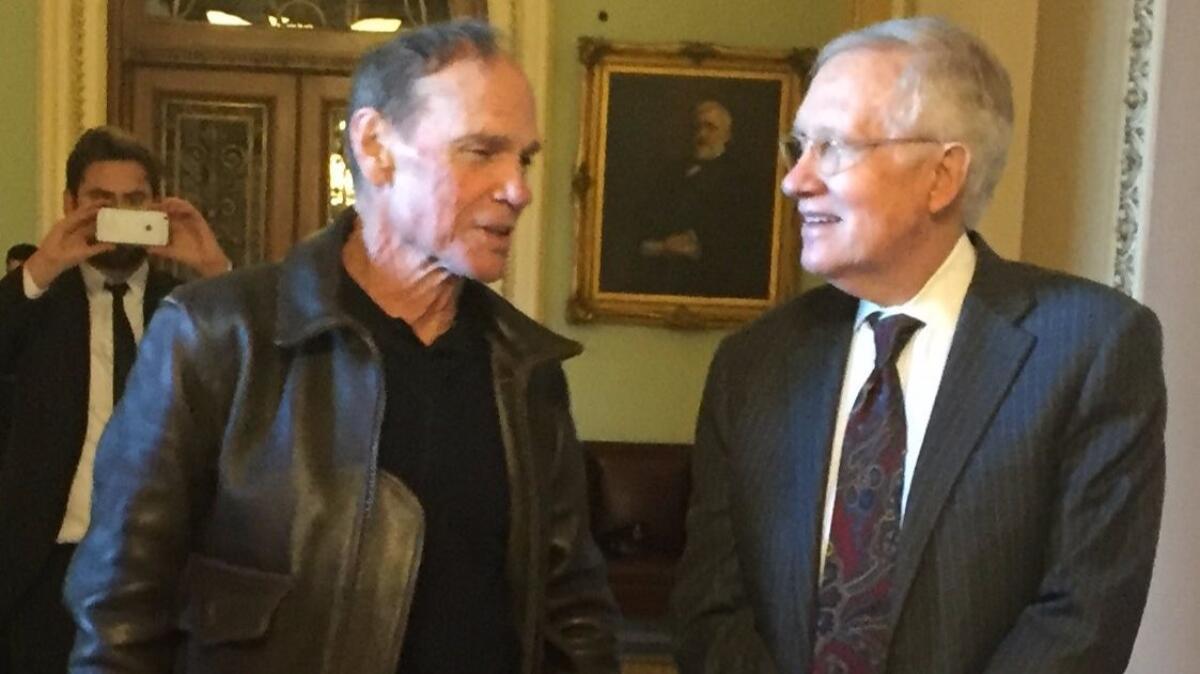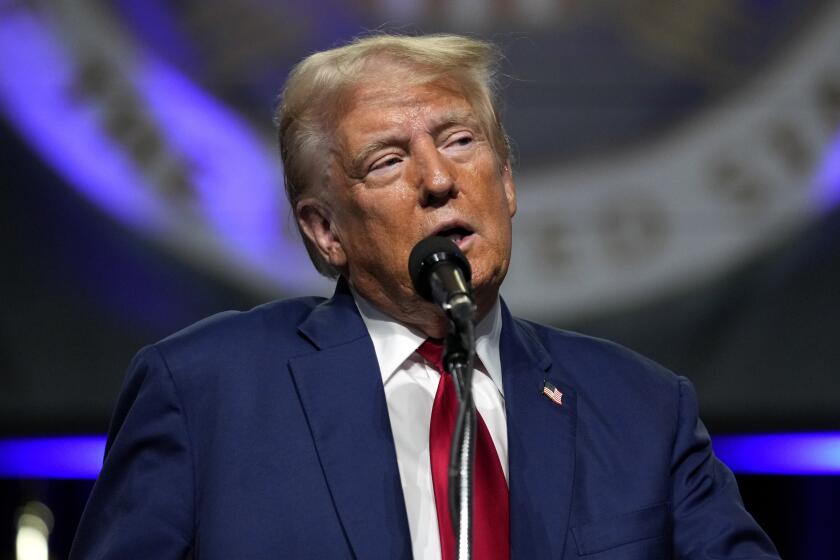The artist and the senator: One built a desert masterpiece, the other a Nevada legacy
Reporting from Washington — When Sen. Harry Reid heard about a reclusive artist building a massive land sculpture across desolate acres in the Nevada desert, he knew they should meet.
It’s not just that Reid enjoys eccentrics and fighters, which he does. Michael Heizer had found an unusual way to express the majesty — and artistry — of the same lonely Nevada landscape that formed Reid’s childhood, when he would escape the dismal, rugged conditions of tiny Searchlight to play in the desert’s hidden springs and abandoned fortresses.
Both men discovered in Nevada what many outsiders miss. Far from seeing a nuclear wasteland, a dumping site or even a playground for gamblers, they drew inspiration from Nevada’s quiet beauty.
Heizer created an American masterpiece — a mile-long complex of dirt, rock and cement rising from the desert floor like modern-day pyramids or the Mayan ruins of Chichen Itza.
For Reid, his appreciation for Nevada’s unique landscape became a cornerstone of one of the most lasting yet less-familiar pieces of his political legacy.
The senator ends his lengthy career in Congress known mostly as the crusty Democratic leader who helped broker President Obama’s signature legislative accomplishments and established a new standard for the partisan brawls of Washington.
Back home, Reid will be remembered for literally rewriting of the map of Nevada, fostering a public lands conservation movement that has helped redefine the Silver State.
Not surprisingly, the senator orchestrated the preservation of Heizer’s stunning land art, “City,” personally appealing to Obama to use the 1906 Antiquities Act to proclaim the installation and 700,000 surrounding acres protected as a national monument.
What Michael Heizer has done is about as visionary as anything that one can imagine. It’ll be there for a long time. It’s going to be there forever.
— Sen. Harry Reid
“What Michael Heizer has done is about as visionary as anything that one can imagine,” Reid said recently. “It’ll be there for a long time. It’s going to be there forever.”
But also on Reid’s watch, Nevada’s protected public lands have grown from 67,000 acres of wilderness at the start of his career to more than 4 million acres of new parks, wilderness areas and open spaces today.
Shortly after Reid was elected to Congress in 1982, the small state was on track to become the dumping ground for the nation’s nuclear waste at Yucca Mountain.
As he prepares to leave Jan. 2, the dump site 90 miles north of Las Vegas is a shuttered hole in the mountain thanks to Reid’s advocacy, and the state has instead become a laboratory for solar, wind and geothermal energy development.
And the senator is not finished yet. Reid has asked Obama to set aside one more swath in Nevada – the 350,000 acres of rugged Gold Butte, situated between Lake Mead and the Grand Canyon — for protection.
Obama could announce the new national monument at Gold Butte, not far from renegade rancher Cliven Bundy’s land, before he leaves office.
“His mark permanently will be visible,” said Neil Kornze, a Nevada native and former Reid aide whom the senator helped elevate to director of the U.S. Bureau of Land Management. “We’ll always have his efforts with us.”
Reid’s public lands agenda unfolded slowly and methodically over the decades, but had its start when he was a child in desolate, dusty Searchlight.
Reid didn’t have much growing up. His mom took in the laundry from the local whorehouses and his dad later committed suicide after a tough life of drinking and hard-rock mining.
The closest the senator says he ever got to Disneyland was Piute Springs, desert lands across the California border, with an old fort, volcanic rock and natural springs that were “like a miracle.”
“They had ponds, and floating on the ponds was like what I read about in the books - they had lily pads. They had lilies, white flowers, they had cattails — you could break them apart and that cotton stuff would fly all over,” he said during an interview.
“I could never get that out of my mind,” he said, “because it was so stunning.”
Returning years later, Reid found the area vandalized with graffiti and riddled with trash. He launched what has become a life’s work preserving public lands.
Nearly 85% of Nevada is owned by the federal government, and the land is constantly sought by competing interests. On one side were miners, ranchers and federal agencies who want resource rich acres for development. On the other are outdoor enthusiasts and environmentalists preferring to keep it pristine.
Navigating those constituencies made Reid a powerful force in Nevada. The old-school politician brokered deals that produced winners and losers, friends and enemies. There were landmark deals that auctioned off federal urban lands for development, using the proceeds for schools, conservation and water projects.
Great Basin National Park became Nevada’s first entry in the National Park System, and the Black Rock Desert Conservation Area was created, home to the annual Burning Man arts festival.
At the same time, Reid ensured that Nevada’s lucrative mining industry has thrived, a reflection of his personal roots in an industry often at odds with environmentalists.
Not everyone has been pleased with Reid’s efforts. Farmers and ranchers complain the protections put public lands they depend on for cattle grazing out of reach. Others resent the preference given to solar and wind projects. Some still want Yucca Mountain for nuclear waste storage.
Stan Hardy, a fifth-generation farmer, says Reid “went a little bit overboard” in pursuit of a Teddy Roosevelt-style conservation agenda rather than keeping control of the land with longtime residents. “What legacy is that to leave?”

Heizer’s project, which began in 1972 and is not expected to open to the public until 2020, was an obvious draw for Reid. Not only was he attracted by the artist’s gritty tenacity, the work fit into Reid’s goal of supplementing the gambling industry’s boom-bust cycle with environmental tourism on Nevada’s public lands.
“It’s such a subtle environment, a lot of people don’t even see it, because it’s not overly dramatic,” said Heizer in an interview. “It’s subtly dramatic.”
Heizer, who became known more recently to art enthusiasts for his “Levitated Mass” giant boulder installation at the Los Angeles County Museum of Art, also comes from a family of miners — generations of geologists and explorers who staked implausible dreams in the earth.
As the Garden Valley installation has grown, so has the state. Las Vegas transformed from a gambling outpost to a sprawling suburb of nearly 2 million people.
At times that expansion has threatened his project. Heizer joined efforts to fight off the Pentagon’s plans for MX missile sites nearby. He battled Las Vegas officials who were eyeing water reserves under his project.
A proposed rail line to transport nuclear waste to Yucca Mountain, the “glow train,” almost spelled doom.
The train, later abandoned, would have run east-west across the state, “right through the sculpture,” said Michael Govan, now the director of the Los Angeles County Museum of Art and an early champion of “City.”
Govan, then director at the Dia Art Foundation in New York, started enlisting Washington for support, asking lawmakers to envision the project spanning the length of the National Mall, from the Capitol to the Washington Monument, across the desert in Nevada.
It was a tough sale. “I really got nowhere,” he said — that is, until “we got Sen. Reid out.”
Reid’s security detail blew two tires during the hours-long drive from Las Vegas to the no-man’s land where Heizer has been building.
As soon as the senator stepped out of the truck “he knew immediately that this was a thing for all time,” Govan said. “It was big. It was beautiful. It was American — really American art. And it was in Nevada.”
Heizer walked him through the landscape; Reid compared it to Mt. Rushmore. As they meandered through the structures, Heizer relayed stories of 19th century environmentalist and Sierra Club founder John Muir camping at the site.
Their bond over shared appreciation for Nevada’s desert was instant.
Recalled Kornze: “It was like watching brothers come together later in life.”
Twitter: @LisaMascaro
ALSO
Where fake news came from — and why some readers believe it
Why one Colorado school district voted to let teachers carry guns to class
Dakota Access protests expose raw divisions and emotions in North Dakota
More to Read
Get the L.A. Times Politics newsletter
Deeply reported insights into legislation, politics and policy from Sacramento, Washington and beyond. In your inbox three times per week.
You may occasionally receive promotional content from the Los Angeles Times.











